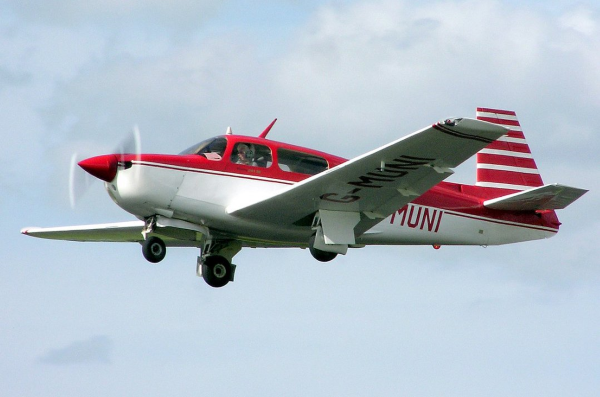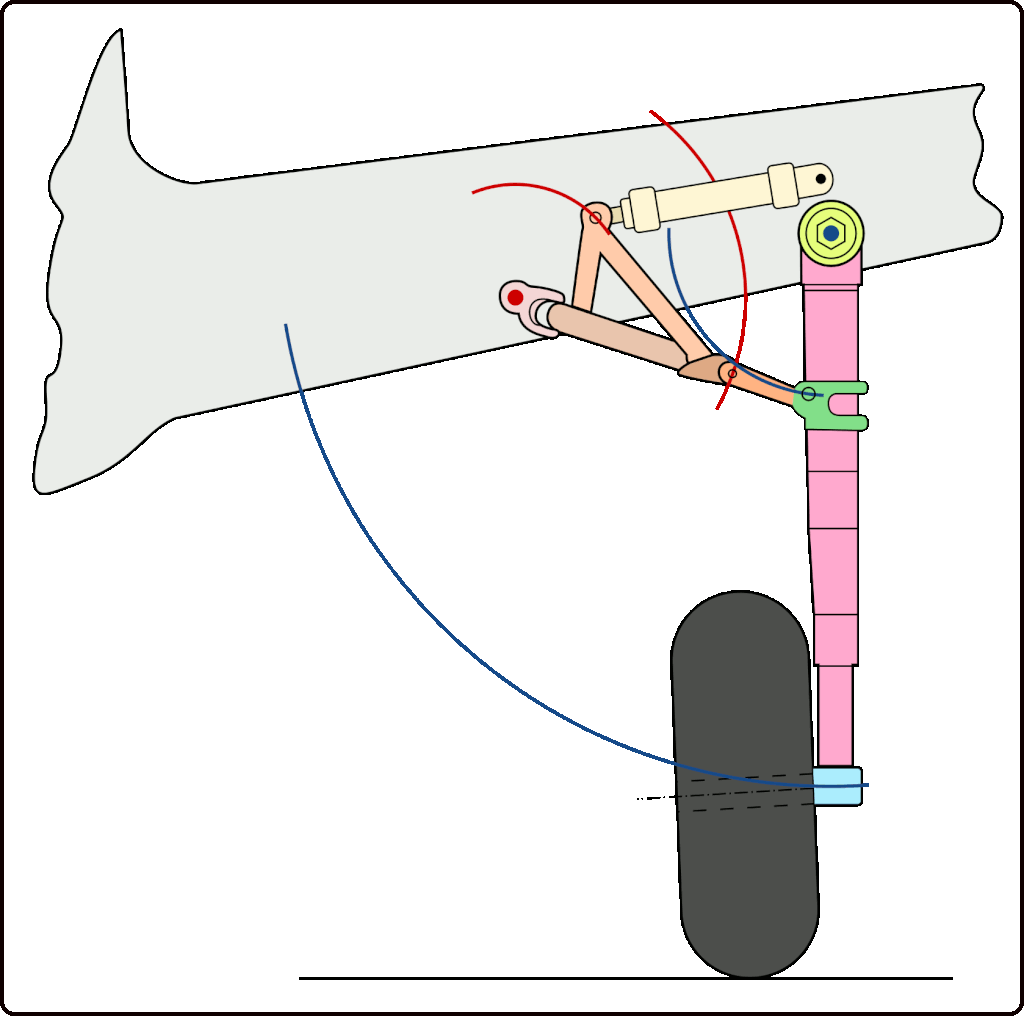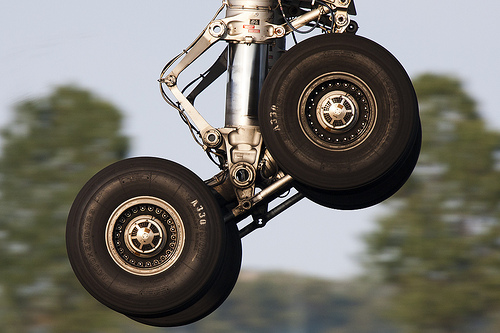Even the Wright Brothers knew that planes needed some way to reduce friction while on the ground to enable roll out and flight.
The easiest solution for this problem are wheels that are low enough to keep the propeller from impacting the ground while the plane is taking off or landing.
The earliest planes had simple landing gears, consisting of two wheels on a single axle below the fuselage.
This solution worked initially. However, as airplane speeds increased, new ways to increase performance needed to be devised.
The downside of landing gear is drag, which decreases top speed and performance.
By retracting the landing gear into the airplane, clean aerodynamic lines can be achieved, increasing speed and performance.
Glenn Curtiss was one of the pioneers of Retractable Landing Gear, using it on the amphibious Curtiss A-1 Triad, allowing it to land on both land and water.
One of the first patents for Retractable Landing Gear was awarded to Leroy Grumman in 1932 as he was pursing military airplane contracts for the US Navy.
In this article, we will discuss all aspects of retractable landing gears, from their history, the types of retractable landing gear, how they work, and more.
Related Article – 5 Types of Flaps Explained
What is a Retractable Landing Gear?

For most typical General Aviation planes that fly less than 200mph, fixed landing gears suffice.
Once speeds go over 200mph, drag increases, and ways need to be found to minimize drag to maintain performance.
The main way planes gain this performance is by using Retractable Landing Gear.
By retracting the wheels and suspension into the fuselage or wings, the main source of parasitic drag is eliminated.
Both conventional and tricycle gear aircraft can use retractable landing gear.
Conventional gear aircraft generally retract the main gear into the fuselage, but sometimes the wings.
The tail wheel may or may not be retractable, and depends on the application, as the wheel is small and doesn’t greatly contribute to drag.
Tricycle gear planes retract the main gear into the fuselage in high wing aircraft, for low wing, either the fuselage or the wings.
The nose wheel is retracted into the cowling underneath the engine.
Many modern planes are able to have the retracted gears flush with the fuselage/wing lines.
Some designs, and many older designs, used cowlings and fairings to retract landing gear into to maintain aerodynamic cleanliness.
The downside to Retractable Landing Gear is the increased weight and complexity of the system, and the added pilot training required to safely use the system.
Retractable Landing Gear can use many methods for retraction, such as electrical, hydraulic, and in some cases, manual.
Backup systems are also employed in the case of failure, and indicators are used to show the pilot whether the gear is down, up, or in transit.
How Does Retractable Landing Gear work?
Retractable Landing Gear can be operated either electrically, hydraulically, or manually.
No matter how they are operated, though, the principles are similar.
The gear and associated suspension system pivots around a bearing system, to which a linkage is attached.
Connected to the linkage is a strut that acts as a lever, and can be actuated via hydraulics, an electric motor, or a manual bar/wheel.
When retracted, the wheels are stored in the wheel wells, and can be located either in the wings or the fuselage.

The gear can only traverse a limited amount, with stops and locks both in the down position and while retracted.
Most aircraft with Retractable Landing Gear have some sort of back up mechanism to raise or lower the gear if the main system fails.
These can include a manual mechanical system involving a hand crank, or a hand pump operating on an independent hydraulic system.
Each gear, the nose gear and two main gear, has an indicator switch that sends a signal to the cockpit.
The gear position indicator shows three green lights if the gears are down and locked.
While in transit, the gear indicator flashes the green lights, or goes to red.
When the gears are up and locked, the lights are normally extinguished to adhere to the dark cockpit philosophy, although some planes have gear up indicators.
Most modern aircraft use a failsafe design, allowing the gear to fall down and lock in place in the event of hydraulic or electrical failure.
This ensures the plane can still land safely, while reducing the chance for airframe or engine damage.
Related Article – 21 Parts of an Airplane Explained
How Electrical Retractable Landing Gear works
Electrical Retractable Landing Gear use an electric motor to actuate the gear mechanisms.
The motor is normally attached to a jackscrew or transmission which is attached to the other linkages in the gear system.
Moving a switch in the cockpit activates the motor, which can operate either forward or backward, depending on whether the gears are going up or down.
The motor will keep operating until the gear activates a stop switch, which is located at both the bottom and the top portion of its travel range.
Because electrical systems use transmission and jackscrews, they normally use hand cranks as a backup system.
How Hydraulic Power Retractable Landing Gear works
Hydraulic Power Retractable Landing Gear use hydraulic pressure to actuate the struts that move the gear mechanism up and down.
They are heavy and complex, but allow for high forces and can be designed for redundancy.
Because of the high pressures available for hydraulic systems, they are used on large and heavy aircraft.
The hydraulic system contains a reservoir of pressurized hydraulic fluid and, when the gear switch is activated, valves open in the system, allowing the pressurized fluid to move into the hydraulic cylinders.
The hydraulic system can be pressurized by a pump in the engine, or by an electrical motor, or both for redundancy.
Some aircraft, like the Boeing 747, have quadruple-redundant hydraulic systems for the landing gear, minimizing the chance of gear failure.
For some airplanes, should the hydraulic pump fail, a small hand pump is available to pressurize the system enough to lower the gear.
How Manually Actuated Retractable Landing Gear works
Only a few older, smaller airplanes, such as Mooneys and Culver Cadets, feature manually actuated retractable landing gear.
In the Mooney, it uses a Johnson bar between the seats, which is a simple lever that actuates the landing gear.
The strength required to actuate the Johnson bar is affected by speed, so lower speeds lead to easier deployment and retraction.
For the Culver Cadet, it uses a rotating hand crank and jackscrew system like some manual backup systems.
It can take over 30 turns of the wheel to retract and deploy the landing gear in the Cadet.
The advantages of manually actuated landing gear are simplicity and reliability, as a properly maintained manual system will rarely experience problems.
Retractable vs Fixed Landing Gear
Fixed landing gear are the best solution to small, low performance aircraft, like most Pipers and Cessnas, due to their simplicity.
There are no moving parts (apart from the wheels themselves) and no extra steps to take into account during takeoff and landing.
While fixed landing gear can rarely fail, the failures are normally due to extreme wear and fatigue, or too much force upon landing.
Retractable Landing Gear help with speed and performance as planes get faster due to lower drag while retracted.
This comes at the cost of increased weight, complexity, and reliability.
Retractable Landing Gear can fail, while it’s almost impossible for fixed landing gear to fail in flight.
It’s also impossible to forget to “retract” fixed landing gear, while forgetting to lower Retractable Landing Gear results in a belly landing with airplane damage.
Frequently Asked Questions (FAQ)
When should you retract the landing gear?
You don’t want to retract the landing gear too soon and risk a prop strike, but you also don’t want to retract it too late and hurt your rate of climb.
You generally want to retract the gear once a positive rate of climb is achieved and the plane is at an altitude in which it can no longer be landed on the runway in the case of an emergency.
If the gear is retracted too soon before a positive climb rate is achieved, the plane could settle back down on the runway, leading to a prop strike and belly landing.
When do aircraft lower their landing gear on approach?
Planes with Retractable Landing Gear have checklists that run at certain points of the flight, and lowering the gear is on the checklist.
There are indications on the airspeed indicator at which a plane can lower its gear. Too much speed can result in landing gear damage.
Generally, the landing checklist is run while in the pattern, and at the very latest, the gear is deployed downwind while abeam the desired touchdown point.
Can you retract landing gear on the ground?
While the rare malfunction does occur, the simple answer is no.
The weight of the airplane on the landing gear activates a switch, called a “squat switch,” which tells the landing gear system the plane is on the ground.
This acts as a bypass, so even if the retraction switch is accidentally activated on the ground, the gear will not retract.
What happens if a plane’s landing gear fails?
If the landing gear fails to go down and the backup systems also fail, it is best to keep the gear in a retracted state vs deployed.
Keeping the gear up makes a belly landing easier and safer.
If possible, it’s best to land on a paved runway instead of a grass strip.
Grass is uneven and if bunched up enough, it could cause a sudden stop, resulting in increased damage and possibly injury.
Paved runways are smoother and lead to more gentle belly landings.
Also, if one gear fails to drop while the others do, this leads to an unbalanced situation upon touchdown.
It can lead to the plane dropping a wing into the ground, which catches the wing and spins the plane around in a ground loop.
Naturally, during a belly landing, the propeller will impact the ground, resulting in damage to the propeller and possibly the engine.
However, it is always prudent to remember that the main priority is occupant safety, and not the integrity of the plane or the engine.
What are some common causes of landing gear failure?
Due to the complexity of retractable landing gear, there are many ways they can fail.
Hydraulic systems can leak, leaving the retraction system low on pressure. Most airliners have multiple redundant hydraulic systems because of this.
For electrical systems, motors and switches can fail.
Up and down locks can either stick or become inoperable, resulting in gears that get stuck up, down, or may make the gear collapse upon touchdown.
Improper or inadequate maintenance can also lead to fatigue, resulting in Retractable Landing Gear failure.
Some failures aren’t in the gear system itself, but in the indicators and sensors.
For instance, a faulty gear up-down indicator can lead a pilot to take actions that are not necessary due to the false reading, another reason extra training is essential.
Conclusion
Retractable Landing Gear were an important advancement in aviation, and have been around for over 100 years.
Initially, retractable systems were used on early amphibious planes to allow them to land on both land and water.
Later, as engine power and speeds increased, Retractable Landing Gear were employed to minimize drag and increase speeds even further.
Starting the 1930’s, military and civilian aircraft started to use Retractable Landing Gear systems en-mass.
They are not normally used on small, low performance planes, as the small increase in speed is not worth the added weight and complexity.
There are three main types of Retractable Landing Gear, Electrical, Hydraulic, and Manual.
Each have their pros and cons, but each operate on the same principles and generally only differ in their actuation system.
Manual systems are the simplest, but are only used on small, low performance aircraft.
Electrical systems are normally used in smaller high-performance aircraft, as they weigh less and are less complex than hydraulic systems.
Hydraulic systems use pressurized hydraulic fluid to actuate the gears, and are the heaviest and most complex.
Because of the high forces generated by hydraulic systems, they are used in the large, heavy airplanes, like airliners.
Hydraulic systems can use engine driven pumps or electric motors to pressurize the fluid, and can have several stages of redundancy, increasing reliability.
While Retractable Landing Gear can fail, they are designed to fail safe, in a down and locked position.
Failures from mechanical issues and lack of maintenance can still happen, though.
However, the biggest cause of belly landings is not due to landing gear failure, but due to pilot error.
As performance and complexity increase, it is essential that pilots stay practiced and trained to avoid an expensive belly landing.
References
https://www.aopa.org/training-and-safety/students/flighttestprep/skills/avoiding-gear-up-mishaps


